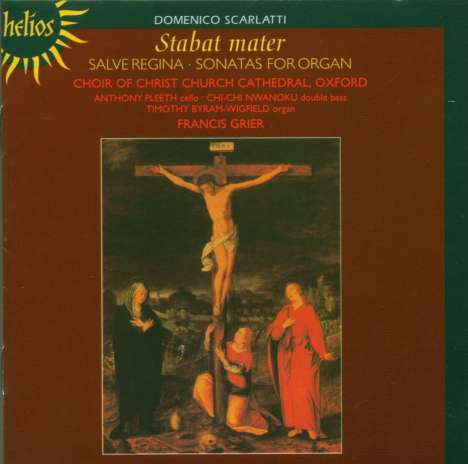Domenico Scarlatti: Stabat Mater auf CD
Stabat Mater
Herkömmliche CD, die mit allen CD-Playern und Computerlaufwerken, aber auch mit den meisten SACD- oder Multiplayern abspielbar ist.
Domenico Scarlattis Renommee beruht heutzutage größtenteils auf seinem enormen Œuvre für Tasteninstrumente (insbesondere den über fünfhundert esercizi, d. h. Sonaten). Seine Opern sind vollkommen vergessen, und von seiner Kirchenmusik ist nur das Stabat mater (Nr. 1), einzigartig in seiner Erhabenheit und Ausdruckstiefe, allgemein in Erinnerung geblieben. Es entstand wahrscheinlich zwischen 1713 und 1719, während Scarlatti an der Basilica Giulia in Rom als maestro di cappella tätig war, und ebenso wie viele andere italienische und italienisch beeinflusste Werke jener Zeit, die ähnlich gefühlsbetonte Texte vertonten (Pergolesis Stabat mater, Lottis achtstimmiges Crucifixus und Hasses Miserere sind andere bekannte Beispiele), bringt seine Verwendung üppiger Texturen und unerwarteter Harmonien im scheinbar strengen Rahmen von zehn Stimmen plus Continuo Effekte hervor, die sich mit dem chiaroscuro in der Malerei vergleichen lassen. Zu diesem Zweck verbindet Scarlatti geschmeidige chromatische Melodien zu einer kontrapunktischen Textur, wie z. B. im einleitenden „Stabat mater dolorosa“, und erzielt starke emotionale Kontraste, indem er beispielsweise die ausgreifenden Skalen des Chorabschnitts „Quis est homo, qui non fleret“ den quälenden Vorhalten des „Quis non posset contristari“ der Solisten gegenüberstellt. Der diatonische Kontrapunkt des „Fac me vere tecum flere“ scheint sich auf die von Palestrina ererbte prima prattica zurückzubesinnen, während das blumige Duett „Inflammatus et accensus“ und das tänzerische „Amen“ zum Abschluss wahrhaft opernhafte Manierismen erkennen lassen.
Product-Information:
Today Domenico Scarlatti’s reputation rests largely on his enormous output of keyboard music (over five hundred esercizi, or sonatas). His operas are entirely forgotten, and of his sacred music only the Stabat mater (track 1), unique in its grandeur and depth of expression, is at all well remembered. It was probably composed between 1713 and 1719, while Scarlatti was maestro di cappella at the Basilica Giulia in Rome, and, in common with the many Italian and Italianate works of this period which set such emotive texts (Pergolesi’s Stabat mater, Lotti’s eight-part Crucifixus, and Hasse’s Miserere are other famous examples), its use of rich textures and unexpected harmonies within the seemingly austere framework of ten voices and continuo produces effects comparable to a painter’s chiaroscuro. To this end, Scarlatti combines sinuous chromatic melodies in a contrapuntal texture, as in the opening ‘Stabat mater dolorosa’, and achieves strong emotional contrasts by, for example, juxtaposing the striding scales of the choral section ‘Quis est homo, qui non fleret’ and the tortured suspensions of the soloists’ ‘Quis non posset contristari’. The diatonic counterpoint of ‘Fac me vere tecum flere’ seems to hark back to the prima prattica style inherited from Palestrina, while the florid duet ‘Inflammatus et accensus’ and the dance-like final ‘Amen’ betray truly operatic mannerisms.
Rezensionen
'I feel no hesitation in awarding this performance, and recording, full marks' (Hi Fi News)
Rezensionen
U.Schreiber in stereoplay 6/87:"Daß Scarlatti, noch in seiner römischen Zeit,auch im geistli- chen Genre Bedeutendes zu sagen hatte, ver- mittelt uns diese technisch vorzügliche Ein- spielung."Disk 1 von 1 (CD)
-
1 Stabat Mater
-
2 Sonate für Orgel D-Dur K 288: Allegro
-
3 Sonate für Orgel G-Dur K 328: Andante comodo
-
4 Sonate für Orgel c-moll K 254: Andante
-
5 Sonate für Orgel D-Dur K 287: Andante allegro
-
6 Sonate für Orgel C-Dur K 255: Allegro
-
7 Salve Regina
Mehr von Domenico Scarlatti
-
Domenico ScarlattiKlaviersonaten2 CDsVorheriger Preis EUR 12,99, reduziert um 0%Aktueller Preis: EUR 7,99
-
Domenico ScarlattiSämtliche Klaviersonaten Vol.12 CDsAktueller Preis: EUR 18,99
-
Domenico ScarlattiSämtliche Klaviersonaten Vol.23 CDsAktueller Preis: EUR 18,99
-
Domenico ScarlattiKlaviersonaten2 CDsAktueller Preis: EUR 42,99







